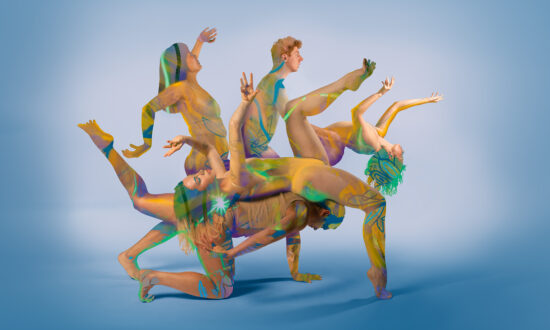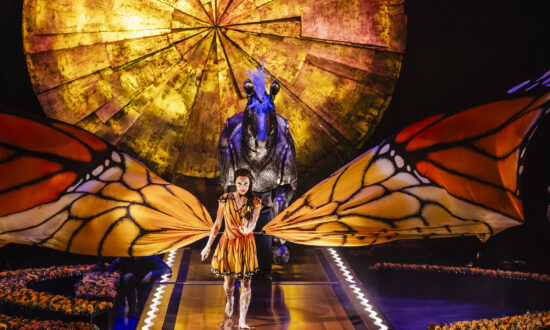The magic begins with the slow dance of smoke across a sheer proscenium screen. It twists and billows, seemingly following the haunting notes of the Adelaide Symphony Orchestra’s wind section. As oboes are overlaid with strings, the passion and drama of the melody builds, then falls away, echoing the trajectory of the fateful relationship at the heart of Tolstoy’s masterpiece.
Lighting shifts, new screens are wheeled into place and, thanks to the combined genius of Tom Pye’s set design and Finn Ross’s projections, we are plunged into a 19th-century Russian train station, the careful chiaroscuro lighting (David Finn) and monochrome colour scheme evoking a scene from the silver screen. Steam from the train hangs in the air as a station guard (delightfully executed by Marcus Morelli) leaps and twirls across the stage, just as the smoke did before him.
As the guard falls to his death on the tracks, Anna (Robyn Hendricks) and lover-to-be Vronsky (Callum Linnane) approach each other on the station platform, draw back and approach again. Eventually the two sections of the platform are whirled away like partners in a duet, carrying Anna and Vronsky stage right and left, before reuniting them front and centre.

Audiences are transported to a 19th-century Russian train station in the opening scenes of Anna Karenina. Photo: Jeff Busby
This stunning prologue is just one example of the complex intertwining, overlaying and echoing of story/music/dance/set/lighting/costume that knits the whole fabulous production together.
The libretto (Valeriy Pecheykin) is the beautifully balanced starting point for this interweaving. The intense drama of intimate pas de deux and trois are interspersed with spectacular, cinematic, large-group interactions. The pomp and splendour of the Moscow ball in Act I is counterbalanced by the golden-lit simplicity of peasants dancing in wheatfields at the end of Act II. Station scenes punctuate the beginning and end of the Anna/Vronsky relationship, while Kitty and Levin’s awkward Act I pas de deux (exquisitely rendered by Benedicte Bemet and Brett Chynoweth) is revisited with the joy and intimacy of true love in Act II.
But it is the perfect pairing of choreographer Yuri Possokhov and composer Ilya Demutsky that sets a backdrop for the clever melding of past and present.
Possokhov’s choreography has an elegant liquidity that gives it a contemporary feel, even though it is clearly rooted in classical ballet. Cabrioles melt seamlessly into fouettés, entrechats into grands jetés. It’s complex (and undoubtedly challenging) work for the dancers yet they make it seem effortless, most notably Hendricks who bends, stretches and leaps with such aqueous fluidity she could be made of water.
Similarly, Demutsky’s immaculate score (perfectly performed by the ASO) pays homage to classic Russian composers such as Tchaikovsky and Prokofiev, yet the occasional use of discordant notes, and some of the variations on the leitmotifs, are very much of the present.

Benedicte Bemet as Kitty. Photo: Jeff Busby
Perhaps it is this like-mindedness of composer and choreographer that brings about the flawless fusion of music and movement. Often it seems that the dancers are not dancing to the music but inside it. The station guard’s solo at the beginning, Kitty’s delicate expression of excitement before the ball, Vronsky’s solo during the séance, Karenin (Adam Bull) and his shadows dancing at the station as he waits for Anna, and Anna’s tormented solo at the end of Act II are all perfect examples, but throughout there is a sense that the music inhabits the bodies on stage, lives through their movements.
Pye’s set and costume design also combine old and new to great effect. Meticulously researched (and utterly gorgeous) period costumes are constructed from the latest fabrics so that they are light enough to dance in. Panels of richly coloured flock wallpaper and single pieces of period furniture evoke 19th-century Russia, but the sparse sets with their rolling transparent screens are synonymous with the 21st.
Lighting by Finn and projections by Ross do much of the grunt work when it comes to atmosphere, sometimes creating literal scenery (a train station or wheatfields), sometimes suggesting context or mood (a close-up of horses’ legs and eyes during the racecourse scene; a needle dripping with morphine when Anna is delirious; the warm, amber light that washes through the scenes in the country), always raising the production bar a little higher.

Australian Ballet’s Robyn Hendricks and Adam Bull. Photo: Jeff Busby
All in all, this is an exemplary adaptation that carries Tolstoy’s classic into the 21st century while masterfully maintaining its 19th-century sensibilities. We began with the ominous billowing of silver smoke but we end with Levin dancing joyfully through billowing sheets of golden sky. It conjures up an adjective that perfectly describes the Australian Ballet’s breathtaking, world-class performance: heavenly.
The Australian Ballet is presenting Anna Karenina at the Festival Theatre until July 15.
Support local arts journalism
Your support will help us continue the important work of InReview in publishing free professional journalism that celebrates, interrogates and amplifies arts and culture in South Australia.
Donate Here



